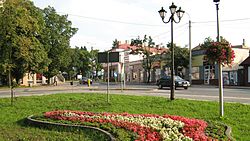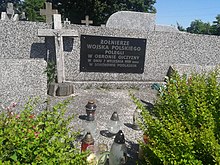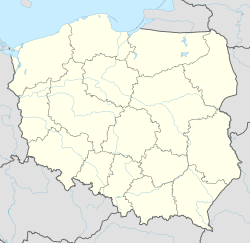Sokołów Podlaski
Sokołów Podlaski | |
|---|---|
 City center | |
| Coordinates: 52°24′24″N 22°14′47″E / 52.40667°N 22.24639°E | |
| Country | |
| Voivodeship | Masovian |
| County | Sokołów |
| Gmina | Sokołów Podlaski (urban gmina) |
| Town rights | 1424 |
| Government | |
| • Mayor | Iwona Kublik (PO) |
| Area | |
| • Total | 17.5 km2 (6.8 sq mi) |
| Population (2019[1]) | |
| • Total | 18,945 |
| • Density | 1,100/km2 (2,800/sq mi) |
| Time zone | UTC+1 (CET) |
| • Summer (DST) | UTC+2 (CEST) |
| Postal code | 08-300, 08–301 |
| Area code | +48 25 |
| Car plates | WSK |
| Website | http://www.sokolowpodl.pl |
Sokołów Podlaski [sɔˈkɔwuf pɔˈdlaskʲi] is a town in Poland, in Masovian Voivodeship, about 80 kilometres (50 miles) east of Warsaw. The town lies on the Cetynia river, in the historical region of Podlachia and is the capital of Sokołów County. The first settlement was in the 6th century and the town received its charter in 1424. The population in 2004 was 18,434 (18,481 in 2010 and 18,720 in 2013).[2]
History
[edit]Middle Ages and early modern era
[edit]
The beginnings of settlement in this area date back to 6th century AD. The Sokołów area belongs to that part of Podlachia, which, due to its location, was a typical settler outpost. This area in early Medieval time was a scene of the feudal fights between the Polish and Ruthenian states, the Teutonic Knights, Yotvingians and Lithuanians. Political history of this land strongly influenced its cultural development and progress of colonisation.
Archaeological research to determinate the cultural and ethnic structure of the settlements discovered numerous archaeological sites from the early Middle Ages in the area, which allowed scientists to accurately reproduce the phases of colonisation process and the character of defensive and residential building structures of the settlements. The archaeologists found evidence of settlements in the area dating from 6th and 7th centuries. Ceramics, iron fittings, buckles, beads, staples and numerous items of burial equipment testify about the culture, customs and rituals celebrated to honour the dead. The study confirmed that in a place of old Russian and Polish settlements in the Cetynia river valley, as a result of gradual colonisation, new settlement at Sokołów was established.[3]
Sokołów Podlaski received city rights in 1424 from the Grand Duke of Lithuania Witold.[4] In 1508, Stanisław Kiszka became the new owner of the town.[5] Administratively Sokołów was part of the Podlaskie Voivodeship of the Lesser Poland Province of the Polish Crown. In 1580, King Stephen Báthory visited Sokołów.[5] Sokołów belonged to Kiszka until 1592, when it was passed to the Radziwiłł family. For Sokołów it was a time of the greatest prosperity in its history, uninterrupted until the Swedish invasion in the middle of the 17th century. During the war with Sweden the city was significantly damaged. In 1657 Rakoczy's army burned down the town together with surrounding farms. During the Reformation, the city was one of the strongest centers of Arianism in Podlachia.[5]
In 1668, Jan Krasiński became the new owner of the town. After the second half of the 18th century, the town belonged to the Ogiński family. Under their rule craftsmanship quickly developed in Sokołów. Michał Kleofas Ogiński brought French craftsmen who started the production of silk scarves, hats, rugs, linen and Slutsk sashes.[3]
Late modern era
[edit]
After the Third Partition of Poland, Sokołów fell under Austrian rule, and after the Polish-Austrian war, in 1809, became part of the Polish Duchy of Warsaw. In 1815, it became part of Congress Poland, later on forcibly annexed by Russia. In 1833, the town was purchased from Michał Kleofas Ogiński by local landowner Karol Kobyloński, who 10 years later sold it to Elżbieta Hirschman. The new owner in 1845 established the sugar factory "Elżbietów" in Przeździatka (today on the western outskirts of Sokołów Podlaski) and in 1890, the factory employed 600 workers.[3] The sugar factory played an important role for the development of the city and local agriculture.
During the January Insurrection, local priest Stanisław Brzóska became a famous leader of the Polish resistance against Russian rule. He was arrested, sentenced by the tsarist authorities to death by hanging, and executed in the town centre on 23 May 1865. In 1925, a granite monument was erected as a memorial at the site of Brzóska's execution.[5]
In 1867, Sokołów became the property of the state and the district office was established there.[6] In 1887, after the construction of the railway line, the city became an important communication link. Between 1845–1890, the population of the town doubled, mostly thanks to immigrants, the majority of which were Jews, who, being artisans, craftsmen and merchants, made a great contribution to the further development of the town. During this period new factories were opened in addition to the sugar factory.[5] In 1915, during World War I, the Germans entered the city, ending the period of Russian rule, and the three-year period of German occupation began.[5] Sokołów became part of Poland again in 1918, after the country declared independence.
World War II
[edit]
During World War II, Sokołów suffered heavy losses. As a result of the war, 30% of residential and 70% of official buildings were destroyed and the population was drastically reduced. With the beginning of German occupation, many Jews fled. For those who left in August 1941, German authorities created a ghetto, which existed until the end of September 1942. A significant number of the Jewish population were killed in the ghetto and others transported to the Treblinka extermination camp.[7] The liberation of the city took place on 8 August 1944.
Post-war Poland
[edit]
Between 1951 and 1974, the electromechanical, chemical and furniture industries developed significantly.[5] In 1975 a meat processing company was established,[5] which over time, as Sokołów, became one of the largest companies in the Polish meat industry.
Notable residents
[edit]- Zofia Kielan-Jaworowska (1925–2015), paleobiologist
- Joseph Rubenstein and Fannie Turek Rutkowski, parents of Jack Ruby, who murdered Lee Harvey Oswald.
References
[edit]- ^ https://warszawa.stat.gov.pl/vademecum/vademecum_mazowieckie/portrety_gmin/sokolowski/1429011_sokolow_podlaski.pdf.
{{cite web}}: Missing or empty|title=(help) - ^ Ludność. Stan i struktura w przekroju terytorialnym (Stan w dniu 31 XII 2010 r.). Warszawa: Główny Urząd Statystyczny, 2011-06-10. ISSN 1734-6118.
- ^ a b c "sokolowpodl.pl". sokolowpodl.pl. Retrieved Jul 31, 2020.
- ^ "Locatio oppidi Sokolow, terra Podlassia - Wikisource". la.wikisource.org. Retrieved Jul 31, 2020.
- ^ a b c d e f g h "SOKOŁÓW PODLASKI - HISTORIA, PRZEMYSŁ". www.sokolow.4web.pl. Retrieved Jul 31, 2020.
- ^ "Historia powiatu". www.powiat-sokolowski.pl. Retrieved Jul 31, 2020.
- ^ "Księga Pamięci". Retrieved Jul 1, 2023.
External links
[edit] Media related to Sokołów Podlaski at Wikimedia Commons
Media related to Sokołów Podlaski at Wikimedia Commons- Official website
- Sokolow Podlaski, from the Encyclopedia of Jewish Communities in Poland
- Jewish Community in Sokołów Podlaski on Virtual Shtetl


